A Visit with Don Tate …
 January 26th, 2015 by jules
January 26th, 2015 by jules
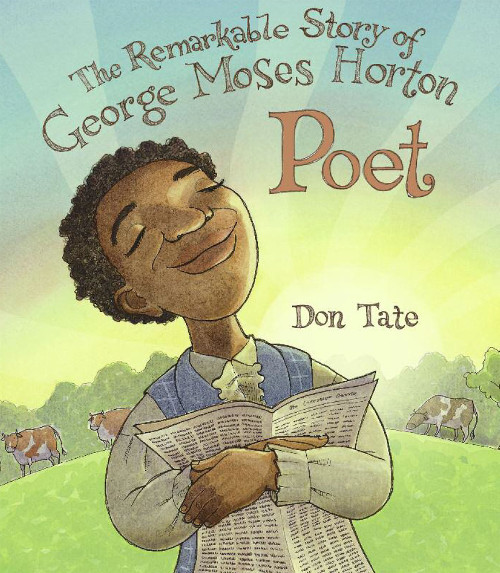
Author-illustrator Don Tate, who visited 7-Imp for breakfast back in 2011, is back today to talk about his upcoming picture books. As it turns out, I had an opportunity to do one of those so-called cover reveals for his book Poet: The Remarkable Story of George Moses Horton of Chapel Hill, which will be on shelves from Peachtree in the Fall. (Yes, FALL! I know. Seems so far away.) And then it turned into an opportunity to ask him about the book (I read an early PDF version) and to show some spreads from it, and I’m all for that. Even better. To boot, Don is even sharing some images from another forthcoming book, written by Chris Barton, called The Amazing Age of John Roy Lynch (Eerdmans), which I believe will be on shelves in April. So you’ll see that below too.
Poet is the story of George Moses Horton, the first African American poet to be published in the South. Horton’s story is a remarkable one, and Don talks a bit below about why. Let’s get right to it, especially so that we can see more of his art.
I thank him for visiting.
Jules: Can you talk a bit about your research for this one?
Don: I had so much fun researching Poet: The Remarkable Story of George Moses Horton. It was like putting together a puzzle. The first piece of the puzzle began with a simple “budget line,” as they say in the newspaper business: George Moses Horton was an enslaved poet in North Carolina, who became the first African American to be published in the South. Many poems protested slavery. In order to complete the puzzle, I did a lot of research.
(Click to enlarge)
I began by reading Horton’s own autobiography. It’s a very short but detailed account of his life that was published as a prefix in his second book, The Poetical Works of George M. Horton. The book was published in 1845. The archaic language was tough to understand.
Here’s a sample (which is in the public domain):
…Nevertheless did I persevere with an indefatigable resolution, at the risk of success. But ah! the oppositions with which I contended are too tedious to relate, but not too formidable to surmount; and I verily believe that those obstacles had an auspicious tendency to waft me, as on pacific gales, above the storms of envy and the calumniating scourge of emulation, from which literary imagination often sinks beneath its dignity, and instruction languishes at the shrine of vanity. I reached the threatening heights of literature, and braved in a manner the clouds of disgust which reared in thunders under my feet. …
Okay.
(Click to enlarge)
(Click to enlarge)
So first I had some deciphering to do. One of my best resources came from a researcher at the University of North Carolina’s Wilson’s Special Collections Library. I can’t emphasize how much researchers there helped me to tell this story. I’d ask a question, and they’d return an abundance of information and sources — about Horton’s life; the clothes people wore; images of the old campus; literacy in slave communities. I had way more information than needed, but it gave me the confidence to tell an accurate story. I also consulted with the Chapel Hill Historical Society and the North Carolina Museum of History, and I studied the poetry from his three books: The Poetical Works, The Hope of Liberty, and Naked Genius.
But he didn’t stop writing altogether. …”
(Click to enlarge)
Jules: Did you learn anything that surprised you?
Don: Yes. As mentioned in my Author’s Note, George Horton’s life and the things he accomplished as an enslaved man totally surprised me. Horton was likely the best paid poet of his Southern contemporaries, black or white. He made enough money from his poetry to pay his master for his time, which allowed him to live at the University of North Carolina at Chapel Hill as a full-time writer. He published two books while enslaved and delivered two commencement speeches to graduates. All of this happened a time when African-American literacy was discouraged, devalued, even outlawed. George’s life was full of surprises.
(Click to enlarge)
There was another thing that surprised me. Slavery was a peculiar institution, to say the least. But I was surprised to learn that many slave owners in North Carolina viewed their slaves as family members. Is that strange or what? Slaves were considered the property of their masters. They performed day-long, back-breaking work for no pay. Their diet was typically poor and their clothing inadequate. They could be whipped or even killed by their masters for any reason and with no recourse. Some way to treat a family member, huh?
(Click to enlarge)
(Click to enlarge)
Jules: I like in your closing Author’s Note that you talk about why you wanted to do this book — that you once were adamant about focusing on “contemporary stories relevant to young readers today,” especially given that “whenever the topic of black history came up, it was always in relation to slavery, about how black people were once the property of white people ….” Yet you were moved to tell this story anyway. Can you talk a bit here about why?
Don: As a young child, I was often embarrassed when the topic of slavery came up at school. There were many reasons for that, but mainly it seemed that when it came to the history of African Americans, slavery was the only thing ever mentioned. White kids sometimes made jokes about slavery. Black kids insulted each other by saying mean things like: “You look like Kunta Kente,” who was a character from the movie Roots. If someone got called Kunta, a fight was on! That’s sad when you consider what Kunta Kente went through in his lifetime. He was actually a hero.
while hearing a free black preacher read the Bible.”
(Click to enlarge)
Because of those negative childhood memories, when I first got into the publishing industry, I promised myself that I would not illustrate stories about slavery, that I’d focus on telling other stories of my people. So what changed all of that? It was a journey.
I’m a dad and husband. I’m a provider. First and foremost, it’s my job to earn a living for my family. If I was going to become a published author, I figured that writing stories about apples didn’t make sense if oranges were in higher demand. Know what I mean? So for my first book, I wrote a story about a former slave who became a famed folk artist. I could have written a story about a contemporary African American child who . . . I don’t know, enjoys skateboarding and playing basketball. Which one do you think would have sold quicker?
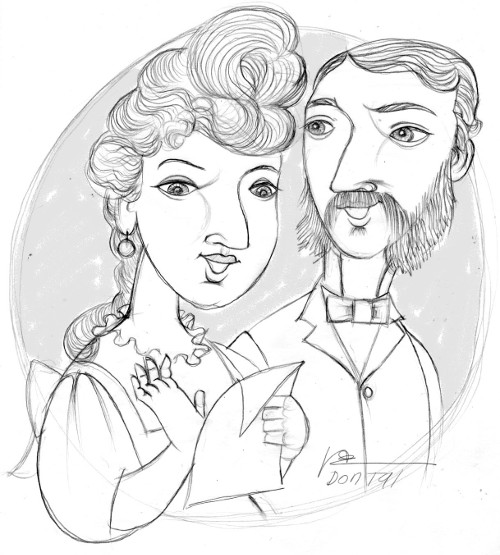
opting to show George reciting a poem while a student wrote it out.”
(Click to enlarge)
But here’s the thing: When I wrote that first book, It Jes’ Happened [art here at 7-Imp], and I studied the narratives of other enslaved African American people, I fell in love with their stories of resilience. Slavery, civil rights, “issue” books? Why not? My people have overcome mountainous obstacles. These are stories that everyone can appreciate and relate to — not only African American children. Inspired, I decided that I wanted to focus my career on telling these important stories.
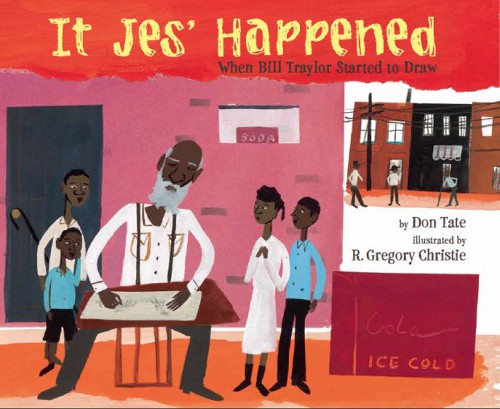
Hope’s Gift (Penguin, 2012), written by Kelly Starling Lyons, was another in that journey for me. It’s the fictionalized story of an enslaved family. The book celebrates the 150th anniversary of the Emancipation Proclamation.
Next up is a story that I illustrated, written by Chris Barton. It is called The Amazing Age of John Roy Lynch (Eerdmans). It tells the story of a young man who in ten years went from teenage field hand to United States Congressman. The story is set during slavery and ends during Reconstruction, the era following the Civil War.
This book also presented many challenges. Reconstruction, which promised bright opportunities, was often a dangerous and deadly time for African Americans, who were basically reenslaved under new laws. Chris Barton dealt with the challenging subject matter honestly, and so did I. Some of the images in the book, like a KKK church-burning and others will generate a lot of discussion. Here are a few images from The Amazing Age of John Roy Lynch.
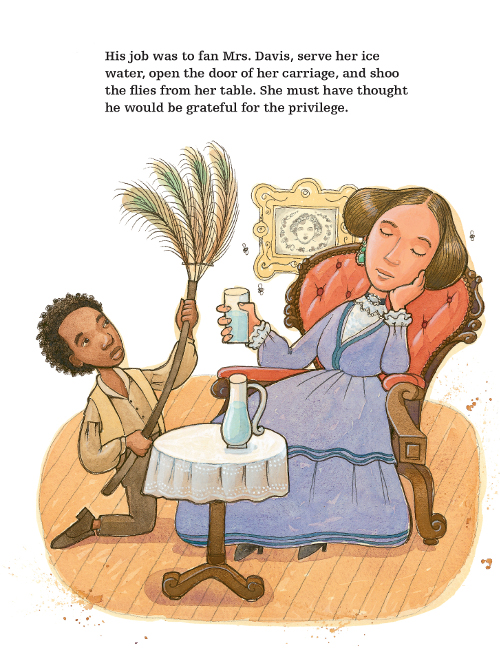
family, faith, free labor, land, education.
John Roy wanted to be part of that.”
(Click to enlarge)
They armed themselves on Election Day to keep blacks away.
They even committed murder.”
(Click to enlarge)
Jules: What’s next for you?
Don: A lot! Currently I’m illustrating a second book for Chris Barton called Whoosh! Lonnie Johnson’s Super Stream of Ideas (Charlesbridge, 2016). It’s the story of the creator of the Super Soaker squirt gun. I’m also creating thumbnail sketches for a book written by Michael Mahin called . . . get ready for it: Stalebread Charlie and the Razzy Dazzy Spasm Band (Penguin, TBD). Whew! I thought I’d never be able to remember that name. But guess what? I can’t forget it! Next up is another book that I wrote that I’m not ready to talk about. It will be published by Charlesbridge and is out to my editor. I expect revision notes soon. I’m very excited about that project.
All images here are used by permission of Don Tate, and the illustrations from Poet are used by permission of Peachtree.
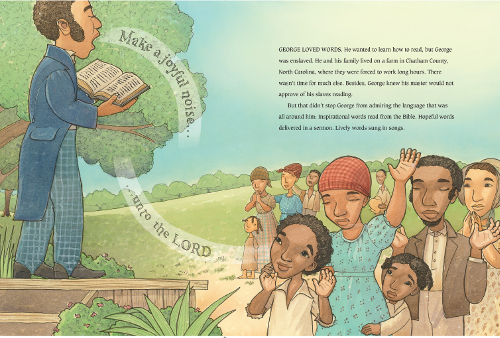
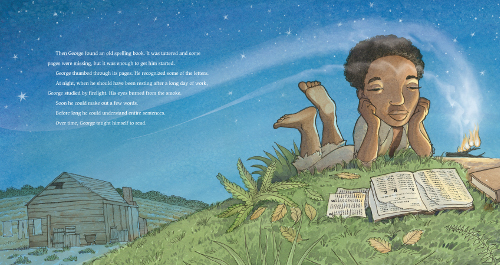
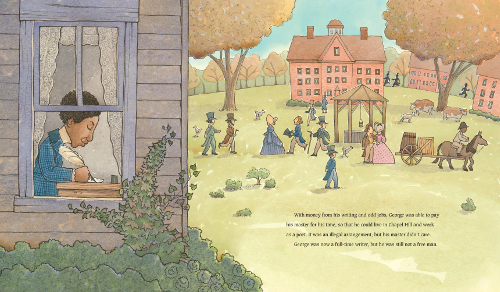


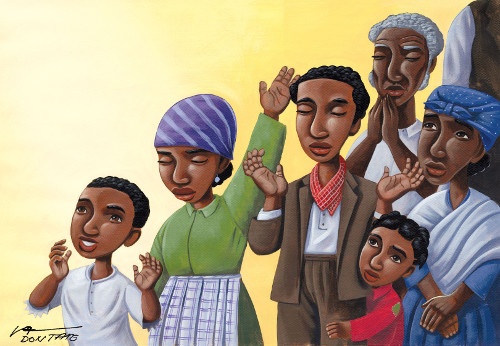
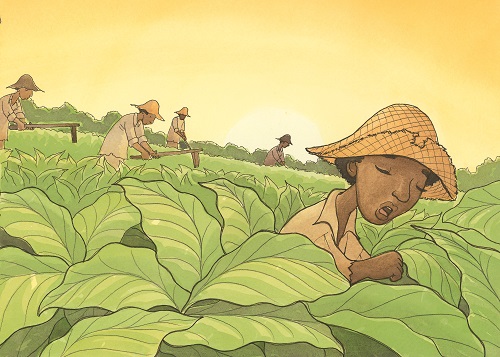
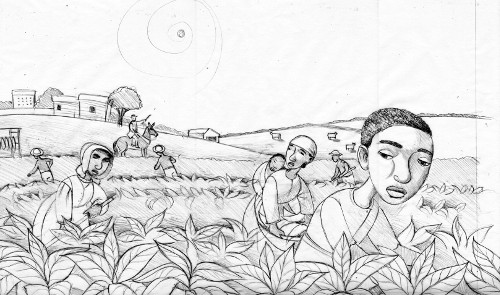
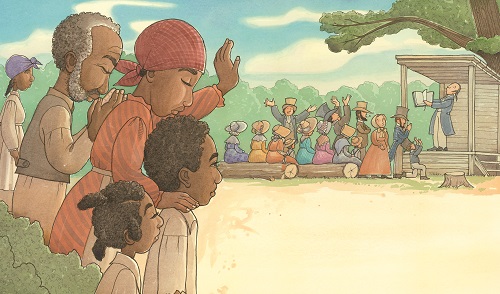
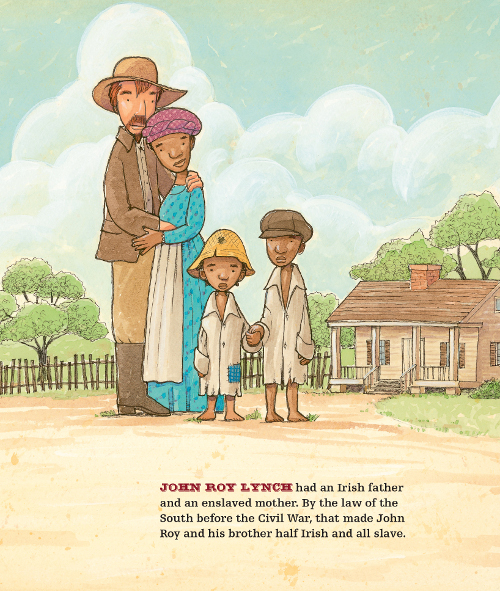
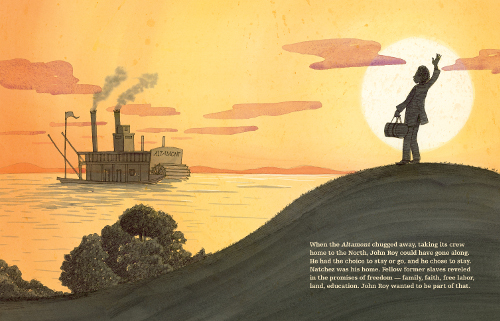
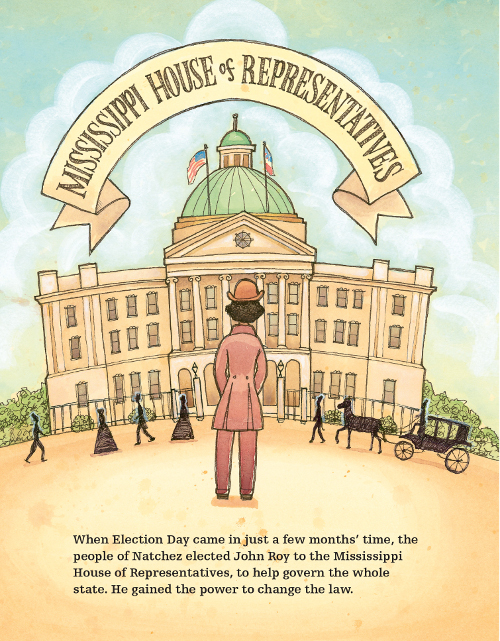


[…] For a generous glimpse of the art from Don Tate’s upcoming book Poet: The Remarkable Story of George Moses Horton of Chapel Hill, as well as from our collaboration The Amazing Age of John Roy Lynch, head on over to Seven Impossible Things Before Breakfast. […]
Interesting and new-to-me stories. Thanks for sharing!
I am so happy Jules and Don that I ended my day stopping by to read this interesting conversation about Don’s books. I am eager to read each one of them. Thank you for sharing the process for each of them.
Great stuff, Don. Thanks, Jules!
Thanks for this early glimpse of POET. I’m so excited to see it, to host Don at TLA, and that this story is coming to life– a great addition to picture book biographies, stories about heroes of African American history, and this look at the power of POETRY! Woo hoo!
Thank you everyone! Labor of love.
[…] can get to know Don Tate, the illustrator partner of The Amazing Age of John Roy Lynch, through his post on Seven Impossible Things before Breakfast. Don shares some lovely stories and illustrations from several of his projects, including The […]
[…] a book called Poet: The Remarkable Story of George Moses Horton (Peachtree, Sept. 2015). It’s the story of an enslaved poet who became the first African American to publish a book in the south. And he published protesting his […]
[…] There’s an amazing interview with Don Tate at Seven Impossible Things that has insight into his process and some really great shots of more illustrations. […]